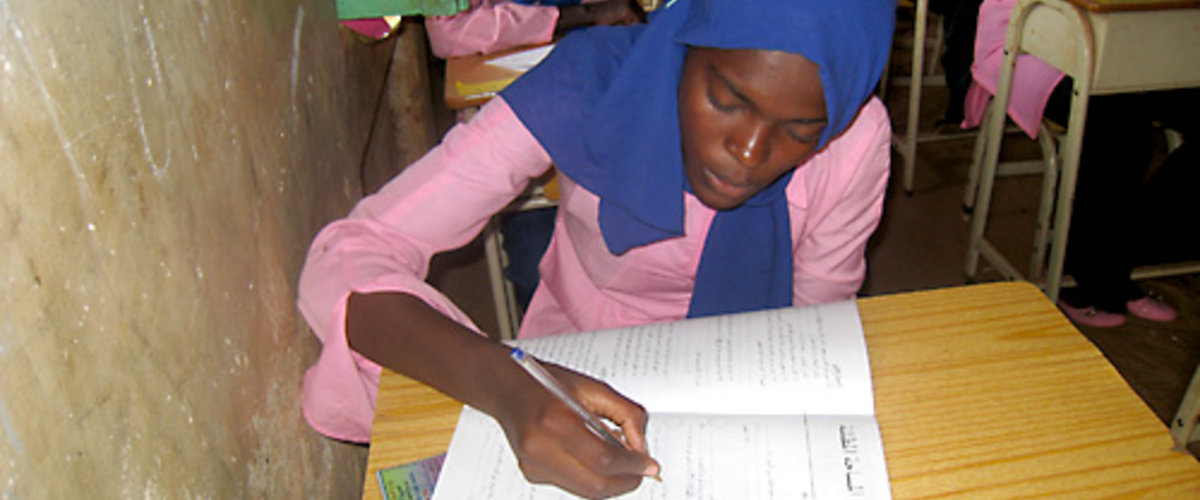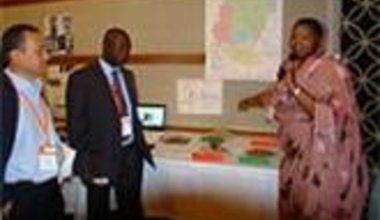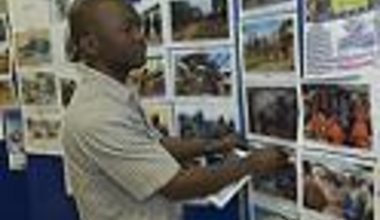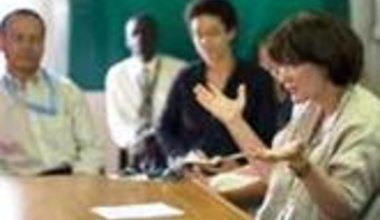Closure of UNMIS
UNMIS wound up its operations on 9 July 2011 with the completion of the interim period agreed on by the Government of Sudan and Sudan People’s Liberation Movement in the Comprehensive Peace Agreement (CPA), signed on 9 January 2005.
The mission ended its six years of mandated operations the same day South Sudan declared independence, following a CPA-provided referendum on 9 January 2011 that voted overwhelmingly in favour of secession.
In support of the new nation, the Security Council established a successor mission to UNMIS – the UN Mission in South Sudan (UNMISS) – on 9 July for an initial period of one year, with the intention to renew for further periods as required.
24 Jan
2011
When Santino Mayen enrolled in a primary school in the Western Bahr El-Ghazal State capital of Wau in 2005, Southern Sudan was just beginning to recover from two decades of civil war that had crippled its educational system.
Now enrolled at the city's John Paul II Secondary School, the 15-year-old student said he felt fortunate to be pursuing his studies at a time of peace, while so many Southern Sudanese in their thirties and forties saw their education interrupted by war.
"I am very happy to be with my family and to attend my school peacefully and freely," Santino said. "Although we have a shortage of reading materials, we are doing fine."
Tangible progress
The six-year-long Comprehensive Peace Agreement (CPA) era has witnessed tremendous growth in the education sector throughout the greater Bahr El-Ghazal region.
Western Bahr El-Ghazal State Minister for Education Adil Athanasius cited a sizable increase in the number of enrolled students and a marked improvement in the quality of education.
At the start of the CPA era in 2005, the total number of students in his state's primary and secondary schools stood at around 23,000. It has now surpassed the 60,000 mark, with female students making up one-third of the student population, according to Mr. Athanasius.
"This shows how people are enjoying peace and investing their time in education," he said.
Warrap State has also registered a significant rise in the number of trained teachers, student enrolment and retention as well as infrastructure improvements, said Kuawyin Wek of the state's Ministry of Education. Total enrolment of primary and secondary school students state-wide rose from 145,703 in 2007 to 171,058 last year.
An even faster rate of growth has been seen in Northern Bahr El-Ghazal State, where student enrolment more than doubled in two years from 54,136 in 2007 to 110,315 by 2009.
"We are working to make sure that every child should go to school," Governor Gen. Paul Malong Away told In Sudan at his office in the state capital of Aweil. "Education is a key for development."
Victorino Ken Akoon of the Northern Bahr El-Ghazal Ministry of Education credited the sharp rise in enrolment in part to the intensive "Go to School" campaigns launched by the Government of Southern Sudan (GoSS) in 2006 to boost the number of primary school students. UNICEF and other educational partners of the GoSS enlisted chiefs, government officials and religious leaders in the effort to get children, especially girls, back into the classroom.
"We have trained a good number of teachers, managed to increase enrolment rates, constructed many new schools and rehabilitated others in collaboration with our education partners," said Mr. Akoon, who serves as the ministry's director of planning and budgeting.
The figures bear him out. The number of schools in Northern Bahr El-Ghazal State soared by 63 per cent in a two-year span beginning in 2007, rising from 500 to 813.
More schools have also opened their doors in the neighboring states of Warrap and Western Bahr El-Ghazal. Warrap State had reported a 16 per cent increase by 2009 when the total number of schools stood at 2,394, and between 2007 and 2009 Western Bahr El-Ghazal added 142 schools to the 664 that existed three years ago.
Go to school
When the "Go to School" initiative was unveiled by the GoSS Ministry of Education, Science and Technology four years ago, the number of primary school students in the country's 10 southern states was estimated at 350,000.
That figure has mushroomed to 1.6 million today, and that includes illiterate adults who have been invited back to school to learn how to read and write.
"I think we have been succeeding in the last six years in terms of school expansions to most areas in the south," said Bahr El-Ghazal University President Stephen Akot Wol. "Although there are some problems and shortages of schools, materials and qualified manpower, we can say the last six years were a success."
Girls' education campaign
The education of girls has ranked high on the agenda. "The most important progress was that the understanding and perceptions of the local people towards education, particularly girls' education, totally changed," said Mr. Athanasius of the Western Bahr El-Ghazal Ministry of Education.
Mr. Wek said the enrolment of girl students in Warrap State had been rising, spurred undoubtedly by the example of Nyandeng Malek, who became the first democratically elected female governor in the history of Southern Sudan when she won the state's gubernatorial race last year.
But Mr. Wek also cautioned that the enduring practice of early marriage in rural parts of the state continued to undermine the formal education of girls, who were often regarded by family members as a source of wealth to attract large wedding dowries.
"Early marriage has dropped a bit in most towns after we campaigned in different parts of the state to convince parents to send their daughters to school," he said. "Currently we are using the governor and other female politicians as motivational figures for girls to go to school."
Crippling shortages
Offsetting these otherwise encouraging trends in the educational sector of the three states is a chronic shortage of qualified teachers, classrooms and learning materials.
"We don't have enough classrooms, and most of our students are attending their classes under trees and open spaces," said Warrap State Minister for Education Madhel Malek Agai. "In most cases, about 200 students sit inside a class which is supposed to accommodate about 50 students in normal circumstances."
The recent switchfrom Arabic to English as the preferred medium of instruction was prescribed by the regional government in Juba, but that policy shift overlooked the widespread use of Arabic among the northern states of Southern Sudan. "It is not correct to change the curriculum from Arabic, which has been spoken by the majority, to English overnight," said Wau teacher Mariel Dut. "I don't believe the decision put into consideration the reality on the ground."
Ministry of Education officials in all three states confirmed that most of their teachers regard Arabic as their mother tongue and have experienced difficulties adapting to the new English-language curriculum.
Exacerbating the language issue was the arrival of over 100,000 southerners from North Sudan in the final two months of 2010. Their children have grown up with the Arabic language, and they will have to start from scratch in classrooms where only English is spoken and read.
"Definitely, the returnees issue is another problem for us right now when it comes to the curriculum," said Mr. Athanasius. "We will either make an extensive programme on English for the newcomers or hire some specialists in English to quickly organize intensive English courses so that students can cope."
All of Southern Sudan's three universities were relocated to Khartoum during the country's second civil war. But they have been moving faculties and students back to the region during the CPA era. Bahr El-Ghazal University President Wol believes that a revival of tertiary education in Southern Sudan will eventually reduce the region's acute shortage of qualified teachers.
Mr. Akoon echoes that view. "We have a blooming hope that these universities will train and fill the gap of qualified teachers after the referendum," said the Northern Bahr El-Ghazal State education official.
Young students like Santino Mayen also anxiously awaited Southern Sudan's self-determination referendum (being voted on as In Sudan went to print), hoping that it would bring them more years of peace and stability to fulfil their lifetime aspirations.
 UN
UN United Nations Peacekeeping
United Nations Peacekeeping





